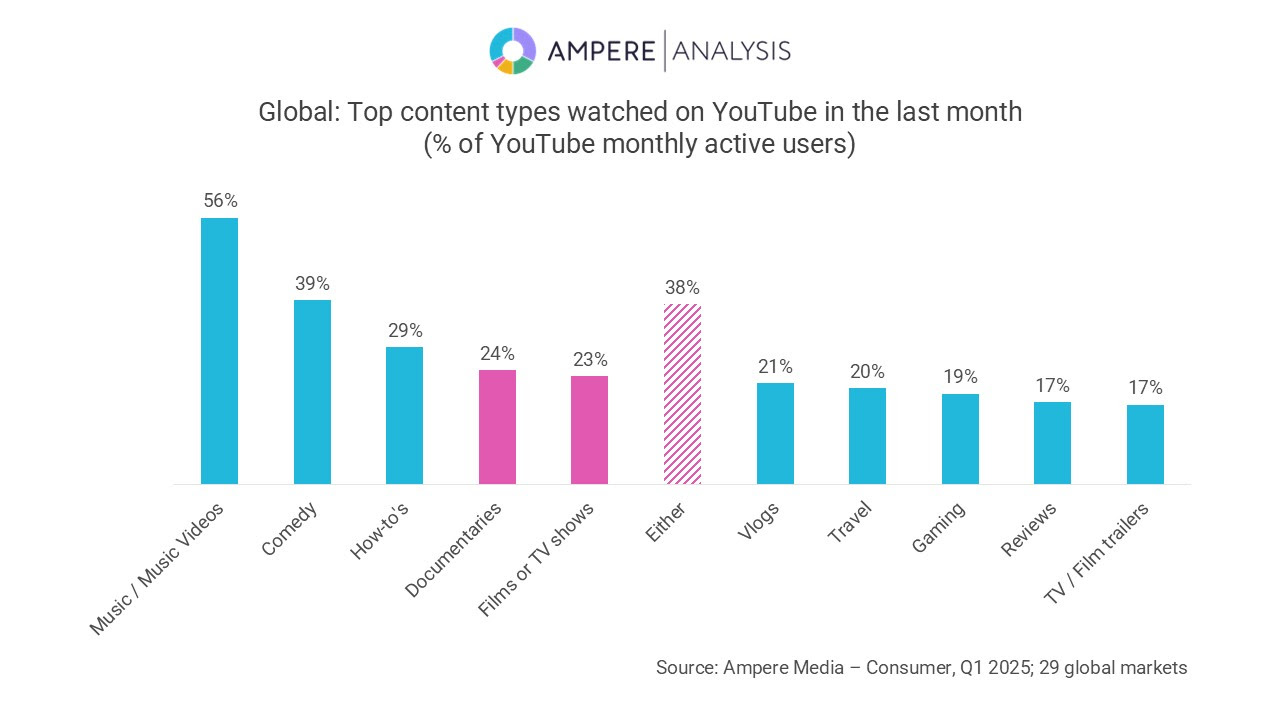Nearly Four in Ten YouTube Users Watch TV and Film Content
Documentaries, TV shows, and films keep users on the platform for longer, growing audiences and boosting revenue, new data from Ampere shows

LONDON–New data highlights how important TV and film content has become for YouTube, with a new Ampere study finding that four in 10 (38%) of YouTube’s global monthly active users now enjoy traditional TV and film content on the platform.
The researchers also reported that documentaries, TV shows, and films are included in the top five most-watched content types on YouTube and that this content is playing a growing role in the platforms success by increasing the time spent on YouTube and creating new revenue streams.
Ampere reported that YouTube has the largest active user base of all online video platforms globally, with 84% of internet users watching it monthly, 73% weekly, and 59% daily. With such an enormous global reach and currently little professional long-form audience overlap by genre, Ampere believes there is huge potential for the platform and content creators to attract new audiences with TV and film content.
“The behemoth that is YouTube, the most-watched online video platform globally, has come a long way since its early days of short, low-quality, user-generated pranks, memes, and vlogs,” explained Daniel Monaghan, senior research manager at Ampere Analysis. “Those types of content are still extremely popular, but we now see more full-length TV shows and movies uploaded from the leading studios, producers, and broadcasters. On one hand, this risks cannibalizing some owned-and-operated audiences. On the other hand, the sheer scale and reach of YouTube mean the benefits of extending the addressable audience cannot be ignored, while also opening up new revenue streams via ad-share agreements with the platform.”
“Documentaries and other TV shows and films sit within the top five video categories as surveyed by Ampere,” Monaghan added. “We expect engagement to grow, especially as YouTube continues to establish itself more firmly in the viewer’s living room on smart TVs, beyond their phones and laptops.”

Key findings of the report include:
- 38% of YouTube monthly active users (MAUs) watched documentaries or TV shows/films in the month prior to the latest wave of Ampere’s consumer research, fieldwork for which ran in February and March 2025
- 24% of monthly active users watched documentaries, making it the fourth most popular content type. TV shows/films were fifth, watched by 23% of YouTube’s MAUs
- Audiences for documentaries and TV/film are largely distinct, with just 22% of their combined viewer bases watching both content types. 37% watched TV/film only, and 41% watched documentaries only
- Documentary, TV, and film viewing on YouTube skews slightly towards 35-44s, and to family households, though it is popular across all demographics
- The content types on YouTube are particularly popular in Asia Pacific, where 45% of monthly active users have watched them, and Latin America, where 40% have. This compares to more muted viewership in Western Europe at 28%. North American viewership is in line with the global average at 37%
- Smart TVs are a popular device for long-form viewing: 34% of those who watched both documentaries and TV shows/films on YouTube in the past month used a smart TV for at least some of their viewing, versus 22% of YouTube MAUs in general (smartphones and computers/laptops remain the most popular devices overall for YouTube content among this cohort, at 77% and 37%, respectively)
- YouTube has the most extensive active user base of all online video platforms globally*, with 84% of internet users watching it monthly, 73% weekly, and 59% daily.
The professional video industry's #1 source for news, trends and product and tech information. Sign up below.
George Winslow is the senior content producer for TV Tech. He has written about the television, media and technology industries for nearly 30 years for such publications as Broadcasting & Cable, Multichannel News and TV Tech. Over the years, he has edited a number of magazines, including Multichannel News International and World Screen, and moderated panels at such major industry events as NAB and MIP TV. He has published two books and dozens of encyclopedia articles on such subjects as the media, New York City history and economics.

